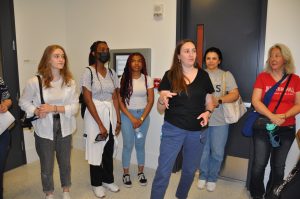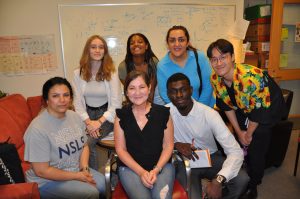
15 from Bunker Hill Community College visited campus as part of an outreach initiative to build stronger ties with local institutions that serve diverse, nontraditional learners.
Lillian Eden | Department of Biology
July 6, 2023
Although many undergraduates may be home for the summer, the halls and labs of MIT are still teeming with activity. On a sunny Thursday in June, 15 students from Bunker Hill Community College (BHCC) got to peek behind the curtain of research at MIT.
The Community College Partnership builds ties with two local community colleges that serve diverse, nontraditional students. The program was first conceived in 2020 as part of the biology department’s participation in #ShutDownSTEM, a day to consider equity and inclusion for marginalized communities and to educate and take action against injustice.
The visit is part of a larger effort to encourage students to pursue research opportunities and careers in research at and beyond MIT; other initiatives include virtual career panels and workshops for students at BHCC and Roxbury Community College. In addition, two community college students perform research as part of MRSP-Bio each summer, thanks to funding from the Packard Foundation acquired by Ankur Jain, Assistant Professor of Biology and Core Member of the Whitehead Institute.

Sarah Sterling, Director of the Cryo-EM facility, loves giving tours because students ask such great questions, and the BHCC students were no exception: they were curious and inquisitive at every stop of their tour. Sterling explained that she chose her position, in part, because she enjoys “facilitating science”—helping researchers use cutting-edge equipment to find answers to their questions.
The students also visited labs in Building 68, Whitehead Institute, and the Picower Institute for Learning and Memory.
Reddien Lab postdoc Thomas Cooke described exploring mechanisms of regeneration in planarians, and Professor Laurie Boyer described the core questions underlying her research on heart development.
“The process of forming tissues and organs works sufficiently well that we’re all here, and we’re all relatively healthy,” Boyer says. “To me, that is remarkable.”
What isn’t well understood, she explains, is how faulty regulation can lead to disease and congenital malformations, and research using model systems can provide answers. For example, creating a model system in a dish can lead to a better understanding of the formation of circuits and molecular players. That, in turn, can lead to therapies or early diagnosis. The lab also works on tools to visualize what is occurring inside cells because “seeing is believing.”
“As scientists, we are not only trying to plan the best experiments possible, but we are also trying to develop new tools that push the boundaries of what we can discover,” she says. “Keeping an eye on the big picture is important because you’re never studying a problem in isolation. You’re studying a biological mechanism that has implications for many different things.”
It was “really eye-opening” to see what’s happening in some of the labs, according to BHCC student Robinson Le. Le is a dancer turned Biology major but had only ever come to campus for breakdancing practice—a skill they showed off to cheering BHCC students during lunch.

Badara Mbengue, another BHCC student, was excited to learn “what everyday life is like in the department.”
“It makes me very happy to see how much this has grown and continues to grow,” says Sheena Vasquez, PhD ‘23, who helped spearhead the initiative.
BHCC alums at MIT also showed students around the labs they are working in and shared their experiences at MIT, including as MSRP-Bio students, Quantitative Methods Workshop students, and as an undergraduate transfer student.
Libby Dunphy, a professor at BHCC, helped arrange the visit. She says the trip was an excellent opportunity for her students, who don’t get much exposure to real research.
“Seeing actual researchers, seeing that they’re real people, and that they’re nice, can help students imagine themselves in this place,” Dunphy says. “The Bunker Hill motto is ‘imagine the possibilities.’ And it’s cheesy, but we’re imagining the possibilities here.”
Boyer also offered advice for pursuing research at this stage in the students’ careers.
“The opportunities are unlimited, and so many people would be happy to support you—but sometimes, you have to ask,” Boyer advises. “Stay ambitious. You should be so proud of yourselves for embarking on this journey.”
